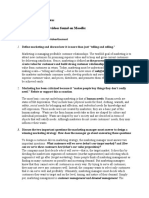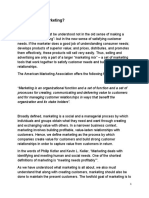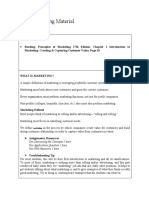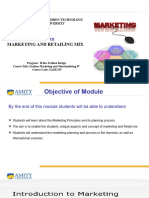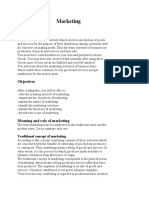mb0046 - Set 2 Solution
mb0046 - Set 2 Solution
Uploaded by
Ahmed BarkaatiCopyright:
Available Formats
mb0046 - Set 2 Solution
mb0046 - Set 2 Solution
Uploaded by
Ahmed BarkaatiOriginal Description:
Original Title
Copyright
Available Formats
Share this document
Did you find this document useful?
Is this content inappropriate?
Copyright:
Available Formats
mb0046 - Set 2 Solution
mb0046 - Set 2 Solution
Uploaded by
Ahmed BarkaatiCopyright:
Available Formats
http://educationblog2012.blogspot.
com/
Q.1 what do you mean by marketing functions? Briefly explain the important marketing functions. A. 1 As an entrepreneur, when we went to start a new business, we don't have a product. In fact we will have to decide what product we should manufacture and sell. We have first to decide what product we should select. This, we can do only if we can do only if we identify the needs which require satisfaction among human beings. Once, we have identified the needs of a group of human beings (or called market segment), we can determine the product which can help to satisfy that needs. This is a part of the marketing concept or we can say the part of modern philosophy of marketing. Philip Kotler, an author in area of marketing defined marketing "a human activity directed at satisfying needs and wants through exchange processes." Human Needs The human need is a state in which a person feels deprived of something. There are many human needs described in many ways. Briefly, these needs can be divided into two types. 1. Physiological needs 2. Psychological and Sociological needs. The physiological needs consist of the need for food, clothing, shelter and even sex. Similarly, there are social needs for belonging, affection and love from others. Of course, there are.higher order psychological needs of self-actualisation. Important to understand that there are different needs for human being on the earth. At any time some needs in a human being are dormant and unsatisfied, whereas others are active and are being satisfied. A marketing man may thus devise a product or service aimed at satisfying a certain dormant need and thus provide satisfaction to the user. This is why a man is often described as a bundle of dormant wants. The need exists buy these have to the converted into 'wants' by a marketing strategy. In a socially competitive society, people may have unlimited wants but the ability to buy may be restricted on account of their economic background. They will, therefore, select from among those products, which give satisfaction or are needed more. Thus, when they are backed by ability to buy, the wants are converted into demand for your product. Therefore, when people decide to satisfy their needs and wants, in terms of marketing activities, exchange takes place.
http://educationblog2012.blogspot.com/
On the current activities of human being, we can develop a process-oriented definition of marketing as "the process of ascertaining consumer needs, converting them into products or services, and then moving the product t or service to the final consumer or user to satisfy certain needs and wants of specific consumer segment or segments with emphasis on profitability, ensuing the optimum use of the resources available to the organisation". In practice, often, separate departments with their own way of perform the business functions, such' as production, finance and marketing, are performed by separate departments with their own way of thinking, production is often considered the more important function as compare to marketing. This practice is, gradually losing ground and it is being recognized that unless you can sell a product, you should not manufacture it. Production-orientation evolved because often products were designed and developed by inventors who hoped that they would sell. However, if these products fail to satisfy some needs they would never sell in the market place. Therefore, consumer oriented thinking becomes necessary for any business to survive and grow. Normally, a salesman would like to think of his activity as a 'selling' process. Wh"en he does this, he is more cohcerned with handling over this product and receiving money in exchange. However, if he adopts the modern philosophy of treating it as a 'buying' process, his job becomes easier. This would definitely help him to start feeling and thinking of a customer. For instance, as he puts himself in the shoes of the customer and asks the question-why should I buy this article? His job will become smoother, as he will then know about the benefits and the disadvantages of the product or the service he is offering. This is an illustration of customer-oriented focus.
Theimportant marketing functions are: Buying - people have the opportunity to buy products that they want. Selling - producers function within a free market to sell products to consumers. Financing - banks and other financial institutions provide money for the production and marketing of products. Storage - products must be stored and protect ed until they are needed. This function is especially important for perishable products such as fruits and vegetables. Transportation -products must be physically relocated to the locations where consumers can buy them. This is a very important function. Transportation includes rail road, ship, airplane, truck, and telecommunications for non-tangible products such as market information. Processing - processing involves turning a raw product, like wheat, into something the consumer can use - for example, bread.
http://educationblog2012.blogspot.com/
Risk-Taking - insurance companies provide coverage to protect producers and marketers from loss due to fire, theft, or natural disasters. Market Information - information from around the world about market conditions, weather, price movements, and political changes, can affect the marketing process. Market information is provided by all forms of telecommunication, such as television, the internet, and phone. Grading and Standardizing - Many products are graded in order to conform to previously determined standards of quality. For example, when you purchase india No. 1 Potatoes, you know you are buying the best potatoes on the market.
Q.2 Define the term Brand Equity ? Discuss the components of Brand Equity. A. 2 Brand equity is a phrase used in the marketing industry to try to describe the value of having a well-known brand name, based on the idea that the owner of a well-known brand name can generate more money from products with that brand name than from products with a less well known name, as consumers believe that a product with a well-known name is better than products with less well known names. Another word for "brand equity" is "brand value". The components of Brand Equity are 1) Awareness, 2) Association, 3) Attitude, 4) Attachment and 5) Activity.
Q.3 Why are marketing channels indispensable? List the functions of marketing channels. A.3 Channel management programs have grown to be an indispensable part of channel marketing nowadays. Channel managers look at these programs as a efficient choice for the management of channel marketing. Today, programs have grown so advanced these help save lot of time and as well as initiatives for the channel managers. You can even install automated channel partner marketing software which usually will get upgraded automatically as channel partners submit information. Automated software is of great advantage as it assists channel partners get more precise data every time they sign in to the portal. Additionally, there are numerous channel management application that aim at facilitating better relationship with channel partner. All these help by building sales as well as technical
http://educationblog2012.blogspot.com/
readiness and also by offering prospects to channel partners to even more enhance sales. The important goal of channel marketing management is to give partners information as and when they require it.
Q.4.Explain the different methods which allows a me dia planner to decide budget allocation A.4 Media vehicle selection, number of insertions and message structure depend on the budget allotted for the communication program. A popular channel may charge more for advertisement but organization gets better viewership. A newspaper having high circulation charges premium for the advertisement but all the organization may not have enough budgets to support such campaign. Hence marketer would like to decide what is the budget for the communication program? And how shall it be allotted optimally? There are four different methods on which a media planner decides the allocation of advertisement budget. 1. Affordable method: The method is used by small companies who dont have enough communication budgets. In this method company allots the fixed amount for the communication program. The advantage of this method is company can have better control over the spending on the communication. The disadvantage is if sales require higher communication effort, company is not in a position to allocate the budget. 2. Percentage of sales method. In this method company allots the budget on the basis of total sales forecasted. This is the simplest method. Marketer can have better control over the budget and also have flexibility to allocate the budget. 3. Competition method: The Company sets its promotion budget on the basis of competitors advertising effort. Here company closely monitors the developments of the competitors communication program and study the industry trends in communication budget prior to setting up communication budget. 4. Objective and task method: The procedure involved in estimating the advertisement budget by this method are First, Objectives are set for the communication programs. Second, identifying the task to be performed to achieve the objective and third, estimating the cost of achieving these objectives. Q.5 Define the term direct marketing Explain the different methods adopted for direct marketing A.5 Direct Marketing : Direct marketing is concerned with establishing an individual relationship between the business offering a product or service and the final customer. Direct marketing has been defined by the Institute of Direct Marketing as: The planned recording, analysis and tracking of customer behaviour to develop relational marketing strategies. The process of direct marketing covers a wide range of promotional activities you may be familiar with. These include: a) Direct-response adverts on television and radio b)Mail order catalogues
http://educationblog2012.blogspot.com/
c) E-commerce (you bought this marketing companion following tutor2us direct marketing campaign!) d)Magazine inserts e)Direct mail (sometimes also referred to as junk mail) f) Telemarketing Q.6 List the important differences between International marketing and Domestic marketing. A.6 Scope The scope of domestic marketing is limited and will eventually dry up. On the other end, international marketing has endless opportunities and scope. Benefits As is obvious, the benefits in domestic marketing are less than in international marketing. Furthermore, there is an added incentive of foreign currency that is important from the point of view of the home country as well. Sharing of technology Domestic marketing is limited in the use of technology whereas international marketing allows use and sharing of latest technologies. Political relations Domestic marketing has nothing to do with political relations whereas international marketing leads to improvement in political relations between countries and also increased level of cooperation as a result. Barriers In domestic marketing there are no barriers but in international marketing there are many barriers such as cross cultural differences, language, currency, traditions and customs.
You might also like
- Marketing Management Full Notes at MbaDocument268 pagesMarketing Management Full Notes at MbaBabasab Patil (Karrisatte)95% (19)
- Marketing AssignmentDocument13 pagesMarketing AssignmentHawe MesfinNo ratings yet
- AnujNigam CV 2022Document1 pageAnujNigam CV 2022Ram Krishna JaladiNo ratings yet
- Marketing Plan For Narra Venture Capital: Ateneo Graduate School of BusinessDocument16 pagesMarketing Plan For Narra Venture Capital: Ateneo Graduate School of BusinessCenon OrielNo ratings yet
- CXC POA SECTION 2: THE CLASSIFIED BALANCE SHEET NotesDocument11 pagesCXC POA SECTION 2: THE CLASSIFIED BALANCE SHEET NotesArcherAcs100% (2)
- Assignment: Marketing ManagementDocument14 pagesAssignment: Marketing ManagementOjal SahuNo ratings yet
- Assignment 6Document17 pagesAssignment 6Mayurdhvajsinh JadejaNo ratings yet
- MarketingDocument17 pagesMarketingYash gawasNo ratings yet
- Marketing:: and Delivering Value To Satisfy The Needs of A Target Market at A Profit"Document11 pagesMarketing:: and Delivering Value To Satisfy The Needs of A Target Market at A Profit"Young Tri TNo ratings yet
- Fundamentals of International MarketingDocument47 pagesFundamentals of International MarketingSUNGLAO, Paula G.No ratings yet
- Marketing Management Unit 1.: Nature, Significance and Scope of MarketingDocument29 pagesMarketing Management Unit 1.: Nature, Significance and Scope of MarketingSimran tariqNo ratings yet
- 2 Mark and 8Document10 pages2 Mark and 8p_s_dominicNo ratings yet
- 8 Marketing ManagementDocument146 pages8 Marketing ManagementAadarshini Gupta100% (1)
- MB0046 Q1: Discuss The Different Marketing Concepts With Its Merits and DrawbacksDocument2 pagesMB0046 Q1: Discuss The Different Marketing Concepts With Its Merits and DrawbacksRahul SharmaNo ratings yet
- Marketing Nature Scope and Company OrientationDocument19 pagesMarketing Nature Scope and Company OrientationSherzad DurraniNo ratings yet
- Marketing PDFDocument360 pagesMarketing PDFcoolNo ratings yet
- Professional EnglishDocument25 pagesProfessional EnglishHâmzaMödrikNo ratings yet
- Chapter 1-3 Review Notes MGN 2210Document8 pagesChapter 1-3 Review Notes MGN 2210KaiNo ratings yet
- Marketing Strategy Done by Pt. IndofoodDocument6 pagesMarketing Strategy Done by Pt. IndofoodRani Candra KurniawatiNo ratings yet
- Answer For Test IiDocument6 pagesAnswer For Test IiDianne DiezmoNo ratings yet
- MB0046 OkDocument12 pagesMB0046 OkKumar GauravNo ratings yet
- Answers - QuizDocument4 pagesAnswers - QuizadilkhanNo ratings yet
- Ameera Hafeeza DBB1104Document7 pagesAmeera Hafeeza DBB1104ameera hafeezaNo ratings yet
- Directorate of Distance Education: Sikkim Manipal University 2 Floor, Syndicate House Manipal - 576 104Document24 pagesDirectorate of Distance Education: Sikkim Manipal University 2 Floor, Syndicate House Manipal - 576 104Sachin JainNo ratings yet
- Introduction of MarketingDocument8 pagesIntroduction of MarketingMohammad Ather AnwerNo ratings yet
- Self Learning Home Task (SLHT) : Region Vii - Central Visayas Schools Division of Cebu ProvinceDocument10 pagesSelf Learning Home Task (SLHT) : Region Vii - Central Visayas Schools Division of Cebu ProvinceJessa A. JakosalemNo ratings yet
- Presntation. 1Document32 pagesPresntation. 1Mangeni DavidNo ratings yet
- Devki Final ProjectDocument52 pagesDevki Final Projectshiv infotechNo ratings yet
- Marketing NotesDocument17 pagesMarketing NotesSaurabh TemghareNo ratings yet
- BBM 212 Principles of Marketing NotesDocument24 pagesBBM 212 Principles of Marketing Notessalim abubakarNo ratings yet
- Draft Asm1 5033Document10 pagesDraft Asm1 5033Nguyễn NhiNo ratings yet
- 1.introduction of MarketingDocument12 pages1.introduction of MarketingNayan KcNo ratings yet
- Sales Promotion PDFDocument63 pagesSales Promotion PDFNitesh Nikode100% (3)
- An Overview of Marketing - Week 1Document7 pagesAn Overview of Marketing - Week 1Jowjie TVNo ratings yet
- Marketin Question, 4,5 6,7,9,10 (OME) 123Document11 pagesMarketin Question, 4,5 6,7,9,10 (OME) 123saddamNo ratings yet
- Definitions of Advertising: The Advertising Communication SystemDocument16 pagesDefinitions of Advertising: The Advertising Communication SystemIshvi ChaudhriNo ratings yet
- 1 - What Is Marketing?Document31 pages1 - What Is Marketing?najamunnisa_starNo ratings yet
- Introduction To Marketing & BusinessDocument32 pagesIntroduction To Marketing & Businesskrisshna_techy301No ratings yet
- 2024 - Marketing Principles - MG 531Document33 pages2024 - Marketing Principles - MG 531bornifacemeleki10No ratings yet
- Marketing Class NoteDocument24 pagesMarketing Class NoteTolulope DorcasNo ratings yet
- Gas - 005 Principles of Marketing Assignment # 1Document9 pagesGas - 005 Principles of Marketing Assignment # 1SMBG KINGSNo ratings yet
- Week 1 Learning Material: Key ConceptsDocument8 pagesWeek 1 Learning Material: Key Conceptshajra ubaidNo ratings yet
- Presentation MODULE III FMM II FASH 235Document26 pagesPresentation MODULE III FMM II FASH 235abhigupta9809No ratings yet
- Marketing Globalization International MarketingDocument5 pagesMarketing Globalization International MarketingRiskyeiNo ratings yet
- Unit 1 MHSDocument7 pagesUnit 1 MHSSaksham SharmaNo ratings yet
- Smu Mb0046 Sem 2 Assignments 2012 Set 2Document8 pagesSmu Mb0046 Sem 2 Assignments 2012 Set 2krishsediNo ratings yet
- What Is Marketing Myopia?: Strategic Planning Vs Tactical PlanningDocument6 pagesWhat Is Marketing Myopia?: Strategic Planning Vs Tactical PlanningRitam chaturvediNo ratings yet
- Mktgnotes From MetDocument53 pagesMktgnotes From MetVijayakumar ManiNo ratings yet
- Marketing Management - 1Document16 pagesMarketing Management - 1dhanushpramod22No ratings yet
- A Study On Affiliate Marketing Towards Bizgurukul ProductsDocument11 pagesA Study On Affiliate Marketing Towards Bizgurukul ProductsEzhumalai.SNo ratings yet
- Unit 1 and 2 Question and AnswersDocument7 pagesUnit 1 and 2 Question and Answersyuanrihan9No ratings yet
- MarketingDocument54 pagesMarketingKaran OchaniNo ratings yet
- Vinay Ch1ansDocument4 pagesVinay Ch1ansMukeshKumawatNo ratings yet
- Marketing Management Full Notes at MbaDocument308 pagesMarketing Management Full Notes at MbaBabasab Patil (Karrisatte)100% (1)
- MarketingDocument76 pagesMarketingAmanNo ratings yet
- A Study On Consumer Satisfaction in Honda Two WheelersDocument32 pagesA Study On Consumer Satisfaction in Honda Two WheelersJayasudhan A.SNo ratings yet
- MM - Unit 1Document22 pagesMM - Unit 1Sparsh SaxenaNo ratings yet
- Marketing Notes For StudentsDocument11 pagesMarketing Notes For StudentsArushi AwasthiNo ratings yet
- IT142 Module 5 - MarketingDocument12 pagesIT142 Module 5 - Marketingletnig953No ratings yet
- Q-1: What Is Marketing? Give Suitable Illustration. Why Is It Important? Briefly Explain in Context of 21st Century. AnswerDocument5 pagesQ-1: What Is Marketing? Give Suitable Illustration. Why Is It Important? Briefly Explain in Context of 21st Century. AnswerRedwanul Kabir DigontaNo ratings yet
- Marketing: Nature, ScopeDocument360 pagesMarketing: Nature, ScopeParamasivam Sundararajan100% (1)
- Q-1: What Is Marketing? Give Suitable Illustration. Why Is It Important? Briefly Explain in Context of 21st Century. AnswerDocument7 pagesQ-1: What Is Marketing? Give Suitable Illustration. Why Is It Important? Briefly Explain in Context of 21st Century. AnswerRedwanul Kabir DigontaNo ratings yet
- MemsDocument21 pagesMemssatyadev555No ratings yet
- LRRDocument27 pagesLRRGurpreet Singh WaliaNo ratings yet
- Landmines DetectionDocument24 pagesLandmines DetectionSudip Pradhan100% (1)
- DTMDocument33 pagesDTMcsestudent1No ratings yet
- Dense Wavelength Division MultiplexingDocument22 pagesDense Wavelength Division Multiplexingsvt4bhosaleNo ratings yet
- 75mimo Wireless Channels Capacity Performance PredictionDocument13 pages75mimo Wireless Channels Capacity Performance PredictionVineeth KommuruNo ratings yet
- Establishing Sweet and Affordable, Cravings Satisfier Milk Tea in Brgy. Balian Pangil LagunaDocument4 pagesEstablishing Sweet and Affordable, Cravings Satisfier Milk Tea in Brgy. Balian Pangil LagunaJoed Michael MerañaNo ratings yet
- Strategic Capacity ManagementDocument36 pagesStrategic Capacity ManagementRahul KhannaNo ratings yet
- ITC Market SegmentationDocument14 pagesITC Market SegmentationNikith KumarNo ratings yet
- Chapter 14 Exercises - Set BDocument6 pagesChapter 14 Exercises - Set BHeather PaulsenNo ratings yet
- Marketing Project Topics and Materials in NigeriaDocument21 pagesMarketing Project Topics and Materials in NigeriaProject ChampionzNo ratings yet
- Strategic Management 3-4Document16 pagesStrategic Management 3-4Semih EminiNo ratings yet
- Lobrigas - Week2 Ia3Document39 pagesLobrigas - Week2 Ia3Hensel SevillaNo ratings yet
- ARest of Theories ParDocument92 pagesARest of Theories ParJireh Mae RiveraNo ratings yet
- Events After Balancesheet Notes-1Document28 pagesEvents After Balancesheet Notes-1sudeis omaryNo ratings yet
- My MGT 301 Final Term Subjective NotesDocument7 pagesMy MGT 301 Final Term Subjective NotesFatima DuaNo ratings yet
- Marketing Performance Review of New Carbon-Fibre Bicycle BrandDocument28 pagesMarketing Performance Review of New Carbon-Fibre Bicycle Brandlucyrt2803No ratings yet
- Group-8 Section-A S&D Group AssignmentDocument19 pagesGroup-8 Section-A S&D Group AssignmentKanishk SinghNo ratings yet
- Ratio Analysis: Profitability Ratio:: Gross ProfitDocument6 pagesRatio Analysis: Profitability Ratio:: Gross ProfitDarshan RavalNo ratings yet
- Financial Economics - Introduction - : Antoine BommierDocument7 pagesFinancial Economics - Introduction - : Antoine BommierSangwoo KimNo ratings yet
- GE11 Business Plan CamucolaDocument36 pagesGE11 Business Plan CamucolaJaspher CayogyogNo ratings yet
- Gee003 - Manuscript - Lean CanvasDocument3 pagesGee003 - Manuscript - Lean Canvasgerlyn montillaNo ratings yet
- Courageous Growth Six Strategies For Continuous Growth OutperformanceDocument12 pagesCourageous Growth Six Strategies For Continuous Growth OutperformanceiamamitxsinghNo ratings yet
- BSBFIN601 Short Questions AnswersDocument13 pagesBSBFIN601 Short Questions AnswersMichael FelixNo ratings yet
- AP Micro 5-5 Unit SummaryDocument66 pagesAP Micro 5-5 Unit SummaryKim TividadNo ratings yet
- Understanding Private and Public Sector BanksDocument8 pagesUnderstanding Private and Public Sector Banksjyotmah14No ratings yet
- U2A1 Balance Sheet TemplateDocument2 pagesU2A1 Balance Sheet Template최성우No ratings yet
- Junr ProjectDocument44 pagesJunr ProjectAvinash GunnaNo ratings yet
- Ch13-Cash Flow STMDocument44 pagesCh13-Cash Flow STMAnonymous zXWxWmgZENo ratings yet
- Template VoucherDocument11 pagesTemplate VoucherDessy WulandariNo ratings yet
- Topic 3 SolutionsDocument13 pagesTopic 3 SolutionsLiang BochengNo ratings yet
- Final Tesco UKDocument20 pagesFinal Tesco UKyohanneshibstu100% (1)
- Chapter 5 Cost and Management AcctDocument35 pagesChapter 5 Cost and Management AcctDebebe DanielNo ratings yet


















